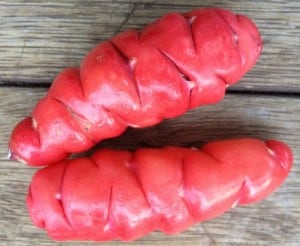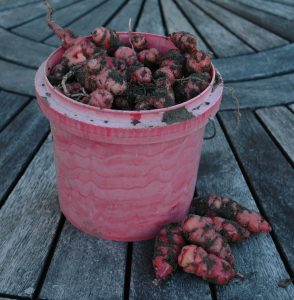We’ve had 3 or 4 good hard frosts already this Autumn. Jack Frost has definitely started his rounds .
Which means it is time to harvest the Yams!
I have to be honest and say that when I see those first frosts, my mouth starts watering thinking about the fact we can soon harvest the sweet morsels hiding beneath the earth.
In America the sweet Potato (known as a Kumara in New Zealand) is often referred to as a Yam but the New Zealand Yam is a small pink/orange tuber that has a slightly shiny surface and typically grow to about 5 cms long and as fat as a large thumb.
These little tubers are sweet and delicious, with the smaller Yams being the most sweet. It’s the littler ones that go most crispy in the oven and are most prized in our home.
Yams grow over the Summer, and into early Autumn, but once the tops start to yellow and die off the precious tubers underneath can be dug up.
This will begin to happen mid to late Autumn but most Yam growers wait for a good hard frost or two to kill off the tops of their Yam plants before digging and I have found that doing so, always produces the best size Yams.
The other key to getting good, fat Yams is to give them plenty of water over the Summer months and continue watering through until the first frosts. Then stop watering them.
Let the tops die away and then dig them up!
It’s best to dig your Yams with a fork because like Potatoes, and other underground crops, you risk cutting into your previous tubers if you just start digging into your patch.
Yams can be buried quite a way down so be sure to turn your patch over thoroughly to get all the good Yams underneath.
The great thing about Yams is that you don’t need to keep planting new ones to get your next crop.
Remove all of the dead top growth and leave all the small Yams that aren’t worth harvesting in the patch. When you turn the soil over just push the little guys under and add in more compost for next seasons food and you should end up with another ‘free’ crop of Yams.
We got got 6 of these buckets, full of delicious fat Yams, just from the tiny tubers not worth collecting last season.
Once you harvest your Yams, store them in a cool dark place, so they won’t sprout. Essentially, treat them like you would Potatoes for storage.
Don’t miss out on the taste of these wonderful little tubers. Once you have tasted them, you’ll understand why they are so eagerly awaited in our household.
Want to know more about gardening ?
Fill in your email address in the form below and you'll receive all the latest updates directly in your in-box.
Thank you for subscribing.
Something went wrong.


In NZ yams are not called kumera..kumera is what people call sweet potato
Yams are not kumera or sweet potato…
Hi Gayle
Yes, this is what I mentioned in the post, that there are other places abroad that refer to the Kumera (or Sweet Potato) as a Yam but in NZ a Yam is a Yam is a Yam : )
Thank you for helping me understand the growing process and n the storage of yams once harvested. Our first year growing the little gems after moving back to NZ from the USA. Loooooving them….
This posting of information on yams is very good, just what I needed to know before harvesting my own crop of yams. Our family loves them too.